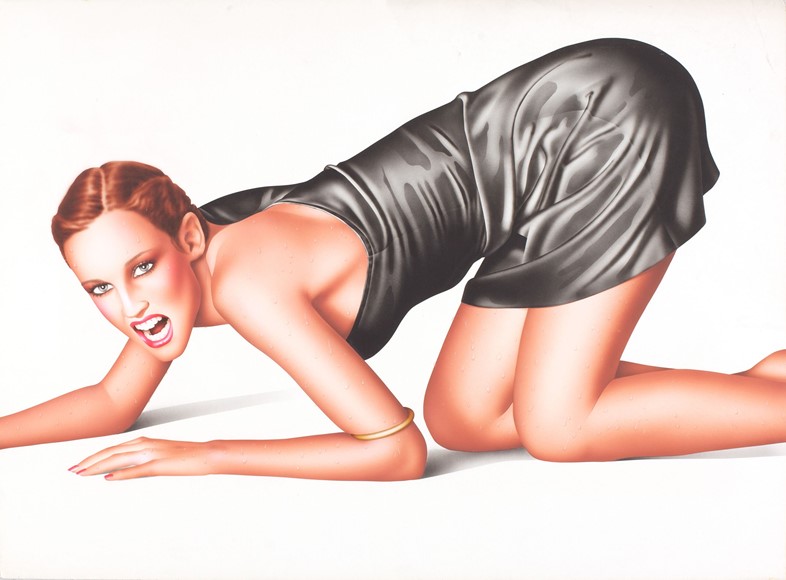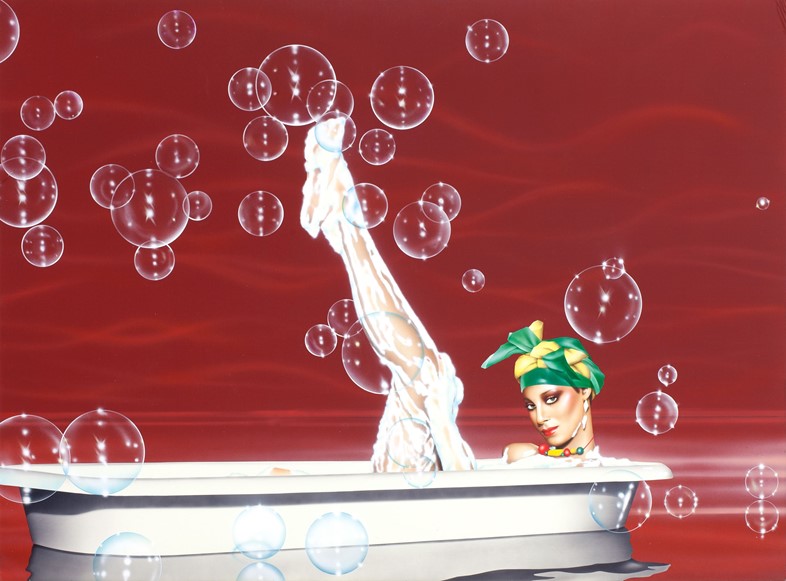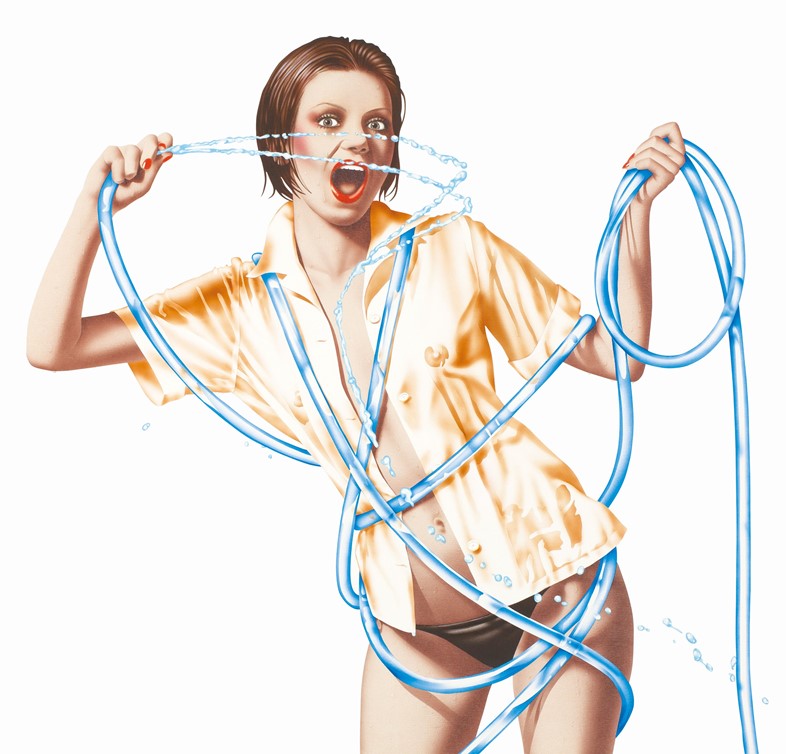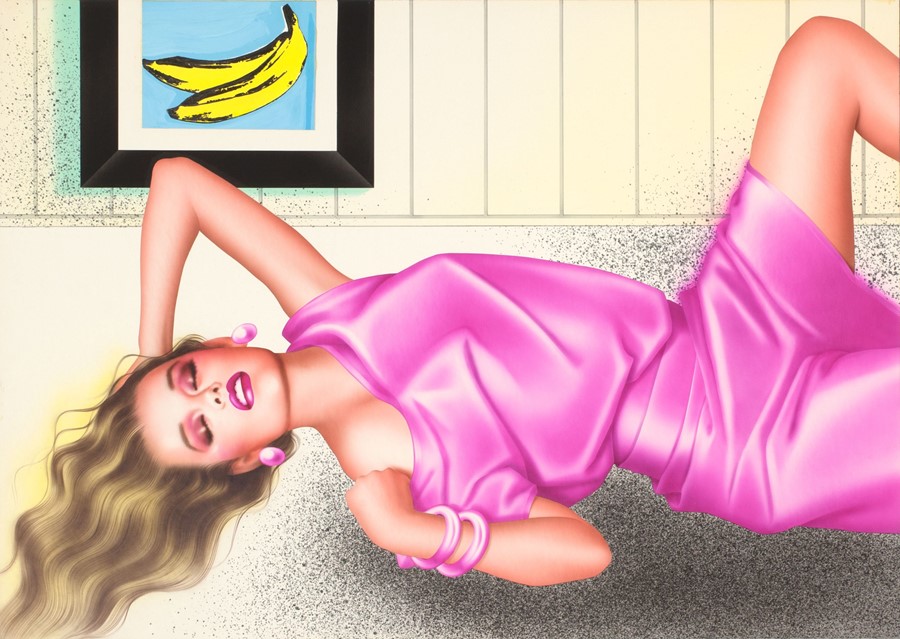As a new exhibition of her pioneering work opens in London, Dal Chodha celebrates Harumi Yamaguchi and her campy hyper-realist paintings
The perfectly unpoised, cocky carefreeness of girl-gaze is well and truly here. Fashion, film and feminism try to promote their wares using “authentic” and “real” female identities, whilst pocketing millions from the perpetuity of self-loathing. Elsewhere we’re assured that the thousands of contorted, well-moisturised limbs extolled on Instagram are a sign of female liberation. So where do the artist Harumi Yamaguchi’s hyper-glamorous, airbrushed babes – painted more than 30 years ago – fit into all of this?
You could misread Yamaguchi’s campy, hyper-realist paintings, now on show at Project Native Informant until 20 May, as almost anti-feminist in their frothy, forthcoming sexuality; yet they are important – if unlikely – works of feminist advertising. These highly saturated paintings of women boxing, playing baseball and skateboarding whilst wearing bright 1980s clothes signalled the changing society that gave rise to modern feminism in Japan.

One of the original gyaru or ‘Shibuya Girls’, Yamaguchi was part of a wave of professionally ambitious, fashion- and trend-conscious women who were challenging male conventions from when they were students in the late 1960s. After graduating from Tokyo University of the Arts she joined a small creative team who had been tasked with the rebranding of the ailing Marubutsu Department Store. It reopened under the new name PARCO in 1969 and for it, Yamagcuhi chose to illustrate the emerging cosmopolitan women performing what had traditionally been male-dominated sports. “I had some friends who began the ūman ribu (women’s liberation) movement,” she says. “And so I felt that the ideal women they strived to be had to meet with the women I depicted in the advertisements for the shop.” Yamaguchi took care to portray active women. Women like herself who felt free to do, dress and act how they pleased. Women who were modern, confident and in control of their own sexuality.
Shibuya Girls asserted their newfound freedom through clothes. “I suppose fashion has become a thing that you choose rather than a thing that is just given to you,” Yamaguchi says. “Women began to think very differently about fashion, and I guess today they now understand that their presence isn’t just to satisfy men. They’re able to imagine the different ways that they want to present themselves but first and foremost for themselves.”

Yamaguchi’s paintings bring together the cheery flesh of Alberto Vargas’ WWII pin-ups and the heady, fecund-glamour of Guy Bourdin’s French Vogue. The author Chizuko Ueno writes in her essay published in connection to 2001’s Women of the 70s PARCO Poster Exhibition 1969-1986 exhibition at the Tokyo Metropolitan Museum of Photography: “while appearing to adhere to the scenario of male-tailored eroticism, Yamaguchi deconstructs male desire through her exaggerative depictions. As a consequence, the female body is idealised to a realm unreachable by male hands.” The women are utterly paralysing in their availability, their sexuality is ripe, confidently displayed but protected by an airbrushed veneer.
There are parallels with Bourdin’s surrealistic haughtiness, yet Yamaguchi’s girls seem to be having more fun. Frolicking, often with each other, there is sometimes the suggestion of a friend’s well-manicured hand tugging at a vest, or a soft hose-pipe snaking around the body. Helmut Newton and Ellen von Unwerth are also key inspirations, Yamaguchi says. “I think that all of their work is sexy but in different ways. Sexuality – and what I mean by that is what I think is sexy – is so multi-layered. It cannot be explained or presented in just one way. It’s this variation that I find so fascinating.” Yamaguchi scrubs away the fetishism of Newton to reveal a youthful friskiness; Von Unwerth’s energy bubbles beneath the surface of the canvases, too.

Yamaguchi’s girls are confident – part pop, part pop tart. Seen within the context of a new wave of young photographers who are busy desexualising the female body, Yamaguchi’s paintings of women bent into, stretched out of and reclining in their own majesty are ripe for our reappraisal.

Harumi Yamaguchi, Selected Works: 1974 – 1985 runs from April 20 until May 20, 2017 at Project Native Informant.
